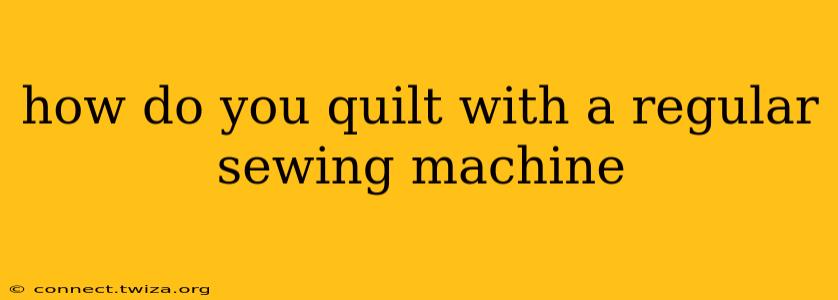Quilting, the art of stitching layers of fabric together, is a rewarding craft accessible to everyone. While dedicated longarm quilting machines offer impressive speed and space, you can create beautiful quilts using a standard sewing machine. This guide provides a step-by-step approach, addressing common questions and concerns.
What Supplies Do I Need to Quilt on a Regular Sewing Machine?
Before you begin, gather these essential supplies:
- Sewing Machine: Any reliable sewing machine will do. A machine with a walking foot is highly recommended, as it helps feed multiple layers of fabric evenly.
- Walking Foot: This specialized presser foot ensures even feeding of all fabric layers, crucial for preventing puckering and achieving a smooth quilt.
- Quilting Fabric: Choose fabrics that complement each other in color, pattern, and texture. Pre-washed fabrics are ideal to avoid shrinkage after quilting.
- Batting: This fluffy layer provides the quilt's warmth and texture. Popular choices include cotton, polyester, and wool batting.
- Backing Fabric: This forms the back of your quilt, and should be slightly larger than your quilt top and batting.
- Quilting Pins or Clips: These hold the layers securely together. Clips are generally preferred as they don't leave holes in the fabric.
- Seam Ripper: For those inevitable mistakes!
- Rotary Cutter, Mat, and Ruler: These tools simplify cutting fabric accurately, particularly helpful for larger projects.
- Iron and Ironing Board: Pressing your seams as you go helps maintain accuracy and neatness.
- Quilting Thread: Use a strong thread designed for quilting, in a color that complements your fabrics.
How Do I Prepare My Fabrics for Quilting?
Proper preparation is key to a successful quilting project. Follow these steps:
- Cut your fabric: Accurately cut your quilt top pieces according to your chosen pattern.
- Layer your fabric: Lay your backing fabric face down on a large, flat surface. Place the batting on top, followed by your quilt top (right side up). Smooth out any wrinkles and ensure the layers are aligned.
- Baste your layers: Secure the layers together using quilting pins or clips. Alternatively, consider spray basting, a method that uses a temporary adhesive spray to hold the layers together. For larger quilts, basting in sections is often easier.
What is the Best Way to Quilt on a Domestic Sewing Machine?
- Start with a simple quilting pattern: For beginners, straight-line quilting is a great starting point. You can stitch lines horizontally, vertically, or diagonally, maintaining even spacing.
- Use a walking foot: This invaluable attachment evenly feeds all layers of fabric, preventing puckering and ensuring a smooth finish.
- Stitch slowly and carefully: Avoid rushing; maintain a consistent speed to prevent fabric bunching or breakage.
- Use a quilting guide: Many sewing machines offer built-in guides or attachments to help maintain consistent stitch spacing.
- Press your seams: Regularly press your seams to keep your quilt flat and prevent distortion.
How Do I Choose a Quilting Pattern for My Sewing Machine?
The best quilting pattern depends on your skill level and the desired aesthetic.
- Beginner-friendly: Straight lines, simple grid patterns, or echoing curves.
- Intermediate: Meandering lines, feather stitching, or simple free-motion designs (requires a darning foot).
- Advanced: Intricate designs, densely quilted areas, or complex free-motion quilting.
How Do I Bind the Edges of My Quilt?
Binding the edges neatly finishes your quilt. Various binding techniques exist, with bias binding often preferred for its flexibility and neat appearance. Consult online tutorials for detailed guidance on binding techniques.
What Are Some Common Mistakes to Avoid When Machine Quilting?
- Uneven feeding: Using a walking foot significantly reduces this, but careful attention is still necessary.
- Pulling or tugging the fabric: Let the machine feed the fabric naturally.
- Using the wrong needle or thread: Select a needle appropriate for your fabric weight and a strong, quilting-weight thread.
- Ignoring seam pressing: Regularly pressing your seams prevents distortion and creates a neater finish.
What Are Some Tips for Quilting Large Quilts on a Regular Machine?
- Quilt in sections: This approach simplifies handling large fabric amounts and reduces strain on your machine.
- Use a larger table or extension table: This provides additional support and workspace.
- Take breaks: Quilting large projects takes time and patience. Regular breaks prevent fatigue and improve accuracy.
By following these steps and practicing regularly, you'll master the art of quilting with your regular sewing machine, creating beautiful and lasting quilts. Remember, patience and practice are key!
